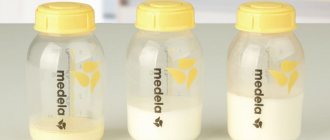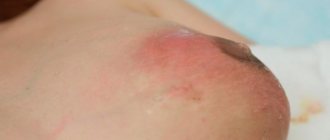Young mothers sincerely worry about their newborn children. One of the main reasons for concern is the peculiarities of feeding infants and the ability to properly establish a full-fledged lactation process. In order for everything to go smoothly and without unnecessary stress, numerous nuances must be taken into account.
How to understand that a child is not getting enough milk
You can understand that a baby is really hungry by the following signs:
- crying and screaming for no apparent reason;
- dry skin;
- restless sleep, weakness;
- rare (less than 10 times per day) urination;
- insufficient weight gain or loss of body weight. During the first month, the baby should gain between 90 and 150 grams each week. From the second to the fourth month, this figure increases to 150-200 grams.
It is also necessary to pay attention to the baby's stool. At the age of up to a month, it occurs up to 12 times a day. Then the frequency decreases and reaches 2-3 times during the day. If stool does not appear for two days or more, this indicates a problem.
The movements and facial expressions of the baby will tell the mother a lot. If he winces, sucks diapers and fingers, and constantly smacks his lips, this means that the baby really does not have enough milk, and he is looking for the breast.
Main signs of malnutrition in infants
- After feeding, a hungry baby will smack his tongue or look for a source of milk with his mouth, and may even suck his finger.
- His behavior may be lethargic and slightly inhibited, and sleep disturbances are possible.
- It may be the other way around, the baby is too active - he can cry often and for a long time, reacts sharply to his mother’s arrival or even her smell.
- A well-fed child urinates up to twenty times a day, and after each feeding he urinates. This indicates that mother's milk is absorbed normally. If the number of these “events” is much less, this is a sign of malnutrition.
- The child does not gain weight well or even loses it in the first month or subsequent months (except for the time spent in the maternity hospital).
- When breastfeeding, the baby does not require any supplements in the first months. You don’t even need to drink water, because breast milk is almost eighty percent water. And a sign of malnutrition can be dehydration, which can be determined by excessive dryness of the baby’s skin.
Why does a child not get enough breast milk?
The main reason that a newborn does not eat enough is a low level of lactation. As a rule, this is caused by an insufficiently balanced diet of the mother. Sometimes a baby refuses to breastfeed because certain foods affect the taste of breast milk.
But even when milk is produced normally, not all newborns receive enough of it. This is possible if, when feeding, the baby takes an uncomfortable position or grasps the nipple incorrectly.
A lot also depends on the psychological state of the mother. Some women experience discomfort or even pain during breastfeeding. Such unwillingness or inability to breastfeed can lead to the fact that the newborn begins to reject it or the milk disappears.
Can breast milk be too thin?
My friend Lenka stopped breastfeeding when Boss Baby - Bogdan to everyone else - was less than three months old. Lenka constantly wailed: what should I do, because she has liquid breast milk. Sometimes it’s cyanotic, sometimes it’s not enough. Ultimately, she gave up and switched the baby completely to formula.
And no arguments like that we are not cows to have the same milk as theirs, and that the boy is gaining weight normally, had no effect on her. She believed that her child was constantly hungry.
And since he’s hungry, that means he needs to be fed. But what breast milk looks like is not an indicator of its nutritional quality.
Natural feeding, no matter how it may seem to us, is the most correct thing for the baby.
How breast milk adapts to your baby's needs
It is known that breast milk has unique properties. Its composition is adjusted to the specific needs of the baby at the moment.
Very often, women compare their milk with what they had “at the very beginning of feeding” after a few months of breastfeeding and worry that it has become “thin and transparent”.
But that's not true. Milk really changes in order to give everything the child needs for normal growth and development: water, micro- and macroelements, vitamins and nutrients. Needs depend on age, appetite, time of day. Milk cannot be the same either.
When breastfeeding, a nursing mother should not try to influence lactation if the milk meets the baby's needs. It is never “wrong,” liquid, or incomplete.
Colostrum
Colostrum is formed during pregnancy, under the influence of the hormone oxytocin, and is released immediately after childbirth.
This is the first transparent milk, its color has a yellow tint. At the beginning of lactation, many people have the impression that colostrum is fatty, although in fact the nutritional components of colostrum are mostly represented by proteins.
Colostrum is secreted so that the newborn’s digestive system gets used to new, unfamiliar conditions of existence, outside the mother; it is rather a building material for the baby’s gastrointestinal tract, and food secondarily. Colostrum has a completely unique composition; the content of nutrients in it is much higher than in milk, which will be released later. At the same time, its chemical composition is closer to blood.
Mature milk
After about 3-5 days, colostrum is replaced by transitional milk, and then within about two weeks it turns into mature milk. This is what the mother will feed the baby until breastfeeding is completed.
Compared to colostrum, mature milk appears denser, has a rich white color and is less fatty in appearance. In fact, its fat content is determined by the needs of the child, and it is two or even three times more fatty than colostrum.
It is customary to divide milk into so-called fore and hind milk. This is the same milk, but during its production and accumulation in the breast, it stratifies a little.
A thin, watery milk comes out forward, closer to the nipple, designed to satisfy the baby’s thirst, and behind there remains a dense fatty mass necessary to feed the baby well.
At the very beginning of feeding, due to the oxytocin reflex (discharge from both breasts in response to the baby’s sucking movements), it may seem that the nursing mother has liquid milk, since it is the front, translucent milk that oozes. But the rear one will definitely follow it, so there is no need to worry about this.
Milk is always ideal for a baby in terms of composition and properties.
It happens that a child cannot suck out hind milk, gorges on the front milk, does not gain weight well, and then doctors and others begin to say that the mother has bad milk. In most cases, the problem is not the composition of the milk, but the child’s improper attachment to the breast. That’s why you shouldn’t constantly shift your baby from one breast to the other during feeding.
And if the baby gets full very quickly, it is better to put him to the breast more often so that the milk does not stagnate and separate and the baby receives that same nutritious hind milk.
After all, a deficiency of hind milk threatens not only poor weight gain for the baby, but also tummy problems. Foremilk has a high sugar content, and it passes through the intestines very quickly. As a result, milk sugar is not absorbed properly, fermentation begins in the intestines, which threatens colic, regurgitation, and bloating.
What to do if your child does not get enough milk
When it became clear that the baby does not have enough mother’s milk, urgent measures must be taken. It is advisable to consult a lactation specialist. If this is not possible, you will have to act independently.
First of all, you need to tune in to the child's needs. You don't have to set your own schedule. It is better to feed the child when he wants: the body itself will tell you the best time. Until the feeding procedure improves, children should not be given water, pacifiers and pacifiers.
Mom should also watch her diet. It is necessary to eat hot food three times a day, try to find opportunities for proper sleep and daytime rest.
Doctors also advise women to drink directly during feeding. This could be tea with milk, warm compote or rosehip decoction. Herbal infusions or special dietary supplements will help increase lactation.
How to make milk more nutritious
It happens that the baby does not eat enough due to insufficient fat content and nutritional value of the milk. Here are some tips to help improve its properties:
- Mom needs to add variety to her diet. The best foods for an infant diet are fruits and vegetables, fish, lean pork, chicken and rabbit. It is good to eat nuts and seeds in reasonable quantities. You shouldn’t go heavy on sour cream, condensed milk and cheese: they contain too much fat. Eating these delicacies will not have the best effect on your figure, and the child does not need such a menu.
- A good way to improve the quality of your milk without putting on weight is to eat brown rice and whole grain bread. It is advisable to eat approximately 230 grams of such products per day.
- To increase the nutritional value of breast milk, you can consume 400-500 calories more per day. A sharp increase is not recommended, since one of the goals of a woman is to gradually lose weight after pregnancy.
- It is necessary to take care of mineral and vitamin supplements. Even high-quality food cannot provide mother and child with the required amount of nutrients. Vitamin B12, which is responsible for brain development, and vitamin D, which promotes the absorption of phosphorus and calcium, are especially important for infants.
- Don’t think that only tasteless foods are beneficial. On the contrary, many newborns like the taste of the delicacies that their mothers eat, and they drink such milk with pleasure.
But in an effort to diversify your diet, do not forget about allergies. If your baby has symptoms, this is not a sign of breast milk intolerance, but a reaction to some of the foods you have eaten. In cases where your baby is restless, develops a rash, diarrhea or wheezing, try changing your diet. If your baby has breathing problems, you can’t wait. Call an ambulance immediately, and the next day discuss your diet with your doctor.
A proper diet is very important for the health of a newborn, but you shouldn’t focus on it. When the mother is in a good mood and does not panic for any reason, the baby is also happy, calm and eats with pleasure.
How to increase the fat content of breast milk for a nursing mother (and is it necessary to do so)
We will tell you how fatty a baby’s diet should be, what these indicators depend on, and what opinion well-known pediatricians hold.
How to influence the fat content of breast milk How to determine the fat content at home What pediatricians say about this What diet should a nursing mother have Folk recipes and tips 3 important recommendations for nursing mothers
In order for a baby to grow and develop correctly, breast milk, which forms the basis of his diet during feeding, must be nourishing, nutritious and sufficiently fatty. Sometimes new mothers begin to feel that the milk the baby is fed with is too watery and unsaturated, “empty,” so the baby doesn’t get enough to eat and doesn’t gain weight.
To understand the quality of lactation, you need to understand whether milk really should be fat, what factors influence this, and, finally, how to increase the fat content of breast milk for a nursing mother.
How to influence the fat content of breast milk
Before seeking to increase the fat content and nutritional content of breast milk, it is important to understand what its properties are. This product is produced through the synthesis of lymph and blood in a woman’s body.
Contrary to popular belief, it does not consist of food consumed. The mother's body begins to accumulate the necessary vitamins, microelements and nutrients during pregnancy. How much fat is in breast milk? The usefulness and fat content of the finished product are optimal for feeding a baby for an average of 6-10 months after birth.
The constituents of breast milk vary depending on the duration of lactation. At the first stage (at the very beginning of lactation), colostrum is produced, which is particularly nutritious and has a fairly high fat content.
The transitional type, synthesized approximately on the fourth or fifth day after the start of lactation, has fewer minerals, but is still quite fatty. When the baby reaches two to three weeks of age, so-called mature, stabilized milk begins to be produced, the baby’s main source of nutrition for the next few months.
This product consists of two fractions:
- “foremilk” - more watery and completely low-fat - replaces the child’s drinking;
- “Hind milk” - dense, thick and nutritious - replaces his food (its average fat content is from three and a half to four percent).
How to determine fat content at home
It is important to understand that when feeding, a woman’s foremilk is first separated, and the baby extracts the “back” part of the product with effort due to the sucking reflex. When a young mother pumps, she may become concerned when she sees foremilk, which looks like water, that is, it is not nourishing enough.
However, before wondering how to make breast milk fatter and more satisfying, it is important to determine the nutritional value of the product you already have. To do this, just pay attention to the baby.
If he is in a good mood, there are no digestive problems, there is a sufficient amount of urination and bowel movements, he is steadily gaining weight (at least 500 g per month) and latch onto the breast without problems, there is nothing to worry about.
You can also do a little experiment. Take a container with a measuring scale and express 100 ml of remaining milk into it. Leave the bottle or flask at room temperature overnight (about eight hours on average).
During this time, the milk will separate and thick “cream” will form on the surface. Fat in an amount of one mm is equal to one percent of the fat content of the product.
Therefore, ideally, a layer of fat of about four mm should form on the surface of the flask.
What do pediatricians say about this?
Dr. Komarovsky and other famous pediatricians are confident that there is no need to consciously try to make the product fattier. Why? Firstly, because the chemical composition of milk does not depend on the mother’s diet. Secondly, by experimenting with the quality of lactation, you can cause digestive problems in the baby.
Since it is not possible to increase the fat content of breast milk in a nursing mother, you just have to learn the basic rules regarding breastfeeding, namely:
- feed the baby on demand, but take sufficient breaks (about two to three hours) so that the baby does not “hang” on the chest all the time;
- feed not only during the day, but also at night;
- give each breast in turn;
- maintain a positive attitude and monitor your psychological state;
- adhere to a proper and balanced diet to ensure healthy lactation.
What diet should a nursing mother have?
How to make breast milk rich and nutritious? To improve the quality of lactation, mothers are advised to eat a varied and healthy diet. To do this, doctors advise:
- limit the consumption of sugar and allergens - citrus fruits, chocolate, unhealthy fast food with an abundance of food additives and preservatives;
- consume enough fiber (in the form of vegetables and fruits) and greens daily;
- replace “empty” white bread with healthier bran bread;
- eat porridge and soups;
- do not forget about healthy dairy products (kefir, cottage cheese, yogurt without additives);
- consume enough healthy fats;
- eat small meals four to five times throughout the day.
The nutritional properties of breast milk have been shown to improve with daily consumption of the following foods:
- cereals (cereals, porridge and bran should form the basis of the nurse’s diet);
- lean fish and meat (chicken, turkey, beef);
- liver;
- walnuts;
- pumpkin and sunflower seeds;
- vegetable oils (they should be consumed at least 15 grams per day, while choosing healthier unrefined options);
- fresh herbs (they can successfully replace hot seasonings to diversify the taste of food).
Ideally, a woman’s daily diet should consist of 25% proteins, 35% healthy fats, and the remaining 40% should be carbohydrates (vegetables, fruits, and primarily cereals).
Increasing nutritional value: folk recipes and tips
To prepare, you need to take an equal amount of honey, walnuts, figs, dried apricots and raisins. Dried fruits and nuts should be ground with a powerful blender or passed through a meat grinder, mixed with honey and eaten one teaspoon before each feeding daily instead of sweets.
Milk nuts
It is recommended to steam walnuts with boiling milk in a heat-resistant pan and leave for one to two hours. After this, the nuts are eaten one teaspoon at a time throughout the day.
Milk tea
Despite the fact that the significance of this drink is questioned by modern doctors, the traditional “grandmother’s” method is still effective in many ways (at least due to the placebo effect created).
Mothers experiencing problems with lactation are recommended to drink green or black tea with added milk.
However, it is important to remember that cow's milk can cause allergies in infants, so it is preferable to add goat product to tea.
Some go further and brew black tea with hot milk instead of boiling water. This composition needs to be left for 10-20 minutes, and then add a little honey to it and drink in small portions throughout the day.
3 important recommendations for breastfeeding mothers
- Many young mothers, wondering how to increase the fat content of breast milk, begin to limit themselves in water consumption.
Under no circumstances should this be done. The amount of liquid you drink does not affect the quality of the milk and does not make it less fatty or filling. In addition, with a lack of water and dehydration, milk may decrease. When breastfeeding, as always, it is recommended to drink at least two liters of pure still water daily. - There is no need to express the front milk and feed the baby only the hind milk, which is fattier and more filling.
The first product replaces water for the baby, which the child’s body needs in the same way as other food. - The problem will disappear by itself if you feed the baby on demand and let him drink as much milk as he wants.
The mother can only monitor her own diet and proper feeding, and the question of how to make milk fatter while breastfeeding will become irrelevant.
Source: https://lisa.ru/moy-rebenok/599552-sytnee-i-poleznee-kak-povysit-zhirnost-grudnogo-moloka-kormyashchej-mame-i-nuzhno-li-eto-delat/









